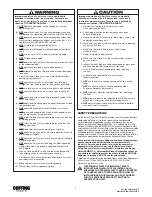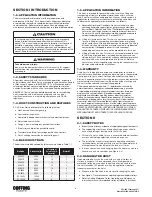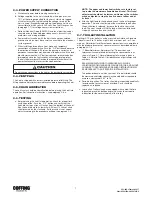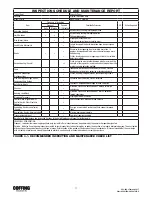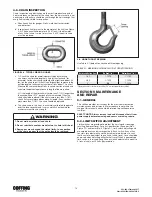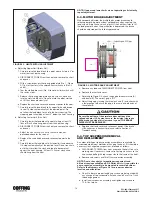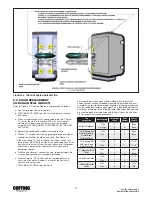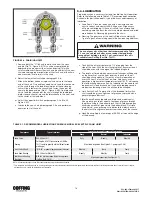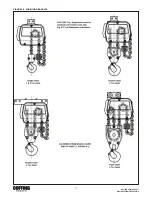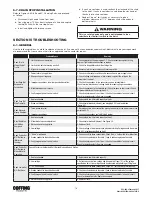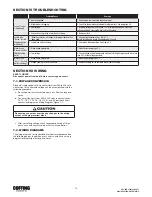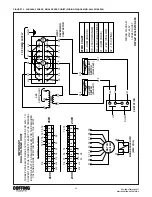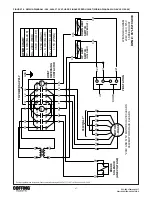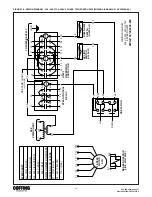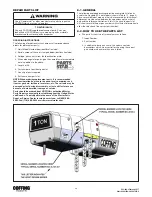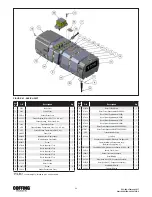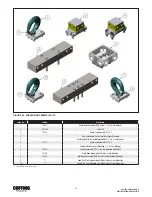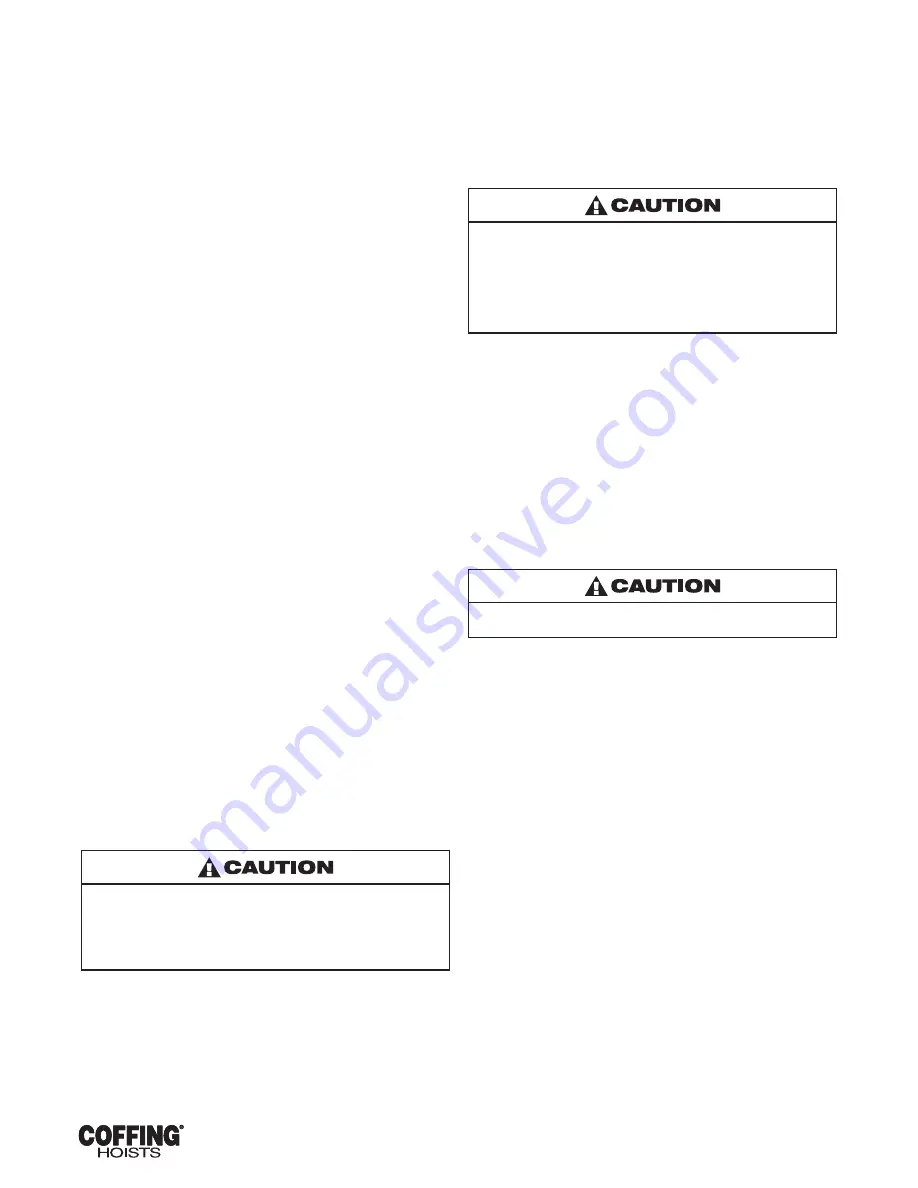
10
EC3-680-3 February 2017
Order # 5041558-0 & 5041679-0
2-8. CHAIN CONTAINER INSTALLATION
a. Operate hoist in “down’’ direction until it is stopped by the limit
switch. Disconnect the slack end of the chain from the hoist
by using a small screwdriver to slide the spring-loaded pin to
the left. At least 12 inches of chain should hang from the hoist.
If less than 12 inches of slack chain is present, readjust lower
limit switch using the procedures detailed in paragraph 5-2.b.
b. Place the chain container in position with the spout toward the
hoist. Place a hex head screw through each mounting chain
with a flat washer between the chain and the head of the screw.
Fasten each of the two mounting chains to the tapped holes on
the side of the hoist, being sure the chains are not twisted.
c. Be sure the end of the chain is started into the container. Run
hoist up until the hook block is even with the bottom of the
chain container.
d. Reset upper limit switch at this position (see paragraph 5-2.a) to
prevent the possibility of raising a load into the chain container.
SECTION III OPERATION
3-1. GENERAL
This section presents information concerning the proper operation
of the Coffing® Electric Chain Hoist. It is not intended to serve
as a handbook on rigging. Rigging, the process of moving heavy
loads using mechanical devices, requires special knowledge and
equipment. For information on the safe use of slings and similar
rigging gear, users are urged to consult a textbook on rigging.
3-2. SAFETY NOTES
a. Inspect the hoist for any sign of loose, broken, or
malfunctioning parts (see Section IV). Any malfunctioning hoist
should be tagged as “out of order” and removed from service
until the defect is corrected.
b. Before starting the hoist, the operator should be certain that all
personnel are clear.
c. Do not lift more than the rated load of the hoist
d. Do not lift people or loads over people.
e. Avoid jogging controls or quick reversals of suspended loads.
f. Do not leave a suspended load unattended.
g. The operator should have a clear view of the load anytime it is
moving and should be sure that the load does not contact any
obstructions.
h. Read ASME I B30.16 Safety Standard for Overhead Hoists.
3-3. HANDLING THE LOAD
a. Align hoist directly over load. Avoid side pull.
b. The hoist chain should not be wrapped around the load. Use
proper slings.
c. Be sure there are no twists in the load chain as it enters the hoist.
This condition should be constantly checked on double or triple
chain hoists because it is possible for the load block to be
“capsized” or flipped over one or more times, putting twist in the
chain. The presence of twist may not be obvious when the hook
block is in the lowered position but can cause serious chain
binding when the hook block is in its fully raised position.
d. Bring the hook into engagement with the load and make sure it is
well seated before proceeding to lift the load. On multiple reeved
hoists, be sure that the load is equalized on all supporting chains.
e. Lift the load just clear of its supports and stop the hoist
to check for proper brake operation.
f. Avoid letting the hook or load swing excessively
while moving a trolley suspended hoist.
3-4. OVERLOAD LIMITING PROTECTION
This hoist is equipped with a factory-calibrated overload limiting
clutch, which will permit the lifting of loads within its load rating,
but will prevent the lifting of damaging overloads while the hoist is
being operated. If the load being lifted exceeds the lifting capability
of the overload clutch, the hoist motor will continue to run, causing
overheating of both the clutch and the motor. This condition should
be avoided by immediately releasing the “UP”’ button and reducing
the load to within the hoist load rating.
The overload limiting clutch is an emergency protective
device and should not be used to measure the maximum
load to be lifted. or to sense the overload imposed by a
constrained load. Manufacturing tolerances require that the
clutch be set somewhat above the load rating of the hoist.
The fact that the hoist will pick up loads in excess of its load
rating does not in any way sanction the use of the hoist in an
overloaded condition.
SECTION IV INSPECTION
4-1. GENERAL
A scheduled inspection routine should be established for this hoist based
upon severity of use and environmental conditions. Some inspections
should be made frequently (daily to monthly) and others periodically
(monthly to yearly). It is suggested that an inspection and Maintenance
Check List and an Inspector’s Report similar to those shown in Figures 4-1
and 4-2 be used and filed for reference. All inspections should be made
by a designated inspector. Special inspections should be made after any
significant repairs or any situation causing suspicion that the hoist may
have been damaged. Any hoist which has been removed from service for
an extended time should receive an inspection as described under Periodic
Inspections. ASME B30.16, Safety Standard for Overhead Hoists, provides
guidelines for hoist operation and inspection.
Any unsafe condition disclosed by any inspection must be
corrected before operation of the hoist is resumed.
4-2. FREQUENT INSPECTION
a. Check pushbutton station, brake, and limit switches
for proper operation.
b. Check hooks for deformation, chemical damage, or cracks.
Bent hooks or hooks damaged from chemicals, deformation,
cracks, or having excessive throat opening (see paragraph 4-6)
should be replaced. Visible deformation of any hook may be
evidence of hoist abuse and overloading and indicates that a
thorough inspection of the complete hoist should be made.
c. Check that bottom hook swivels freely.
d. Check for missing, bent or otherwise damaged hook latches.
e. Check pushbutton and power cord for cuts or other damage.
f. Check load chain for adequate lubrication, as well as for signs
of excessive wear or stretch, cracked, damaged or twisted
links, corrosion or foreign substance.



